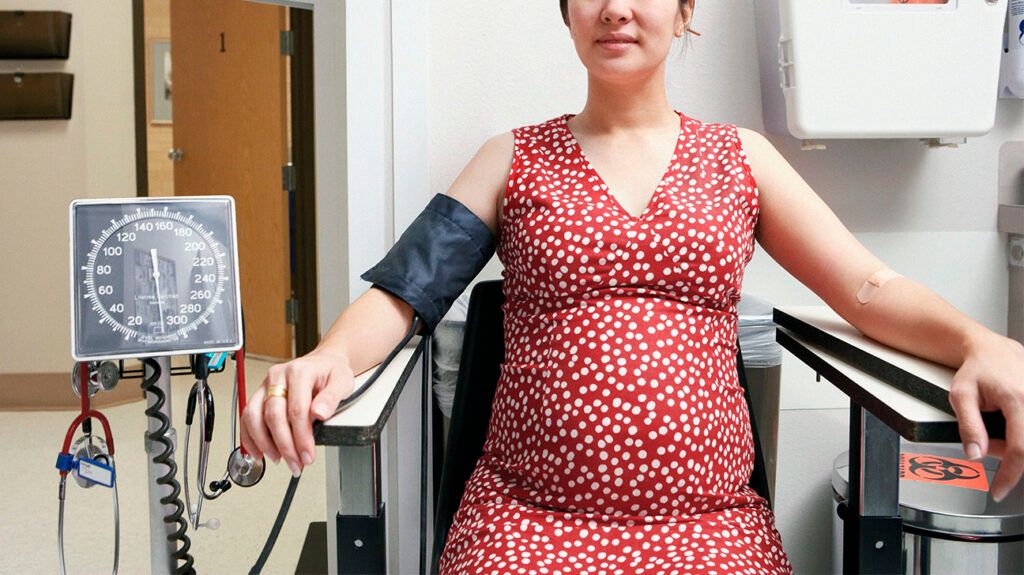Preeclampsia blood pressure range involves a systolic reading of at least 140 millimeters of mercury (mm Hg) or a diastolic reading of at least 90 mm Hg. A person must manifest this on two occasions that are a minimum of 4 hours apart.
In early preeclampsia, people may not show symptoms, or they may have symptoms that are common in pregnancy, such as swollen feet.
This article discusses what constitutes a preeclampsia blood pressure range and what the numbers mean. It also examines the difference between the condition and gestational hypertension, as well as early signs of preeclampsia and when to call a doctor.

Preeclampsia is hypertension (high blood pressure) that occurs after
However, preeclampsia may also denote systolic blood pressure of at least 160 mm Hg or diastolic blood pressure of at least 110 mm Hg. A person must have this on two occasions, but the interval between them may be less than 4 hours.
These ranges are very elevated compared to typical blood pressure of less than 120/60 mm Hg.
In a blood pressure reading, systolic is the top number, while diastolic is the bottom number.
Systolic blood pressure refers to the amount of pressure within arteries during heartbeats.
Diastolic blood pressure is the amount of pressure within arteries when the heart is at rest between beats.
Preeclampsia means that a pregnant person has a condition that can have serious complications, as it can cause death to the pregnant individual and the fetus. It is a
The condition increases the risk of severe high blood pressure, which may result in
- heart attack
- stroke
- injury to the kidney
- retinal injury
- pulmonary edema
- acute respiratory distress syndrome
It may also lead to eclampsia, which healthcare professionals define as preeclampsia plus seizures that happen before, during, or after birth.
Gestational hypertension is a
A feature that distinguishes gestational hypertension from preeclampsia is that the former usually does not involve other symptoms or cause harm to the pregnant person or fetus. However, if gestational hypertension is severe, it links to preterm births and infants who are smaller at birth.
Preeclampsia is gestational hypertension that includes other symptoms. Mild preeclampsia
- fluid in the lungs and difficulty breathing
- blood tests that indicate liver or kidney dysfunction
- visual impairments
Severe preeclampsia may manifest the above symptoms, as well as low platelets — the blood components that enable clotting — and severe stomach pain that does not respond to treatment.
Read more about gestational hypertension vs. preeclampsia.
Many early signs are silent, with a pregnant person not feeling unwell.
Other symptoms resemble typical effects of pregnancy, such as swollen feet, which
In general, signs and symptoms of preeclampsia include:
- hypertension
- elevated protein levels in the urine
- swelling in the hands and face
- blurred vision
- pain in the upper right side of the abdomen
- headache
It is important to keep all prenatal care doctor visits. These visits can reveal if an individual has hypertension, a condition that may not involve any symptoms.
However, if someone develops other symptoms of preeclampsia between visits, such as swelling in the hands and face, they may wish to contact a doctor.
Individuals can speak with a healthcare professional about any concerns they may have. Early diagnosis and treatment can
Preeclampsia blood pressure range entails a minimum systolic reading of 140 mm Hg or a minimum diastolic reading of 90 mm Hg. This must happen twice and involve an interval of 4 hours or more between readings.
However, it may also refer to a systolic reading of at least 160 mm Hg or a diastolic reading of at least 110 mm Hg. This must also occur twice, but the interval between readings may be shorter than 4 hours.
This condition differs from gestational hypertension in that the latter usually does not have other symptoms, such as protein in the urine, or cause harm.
In early preeclampsia, someone may either not have noticeable symptoms or they may have symptoms that are typical in pregnancy. However, it is a serious condition that can lead to life threatening complications for the pregnant person and the fetus.
Early diagnosis and treatment can increase the likelihood of a good outcome. A pregnant individual may try to keep all doctor appointments during pregnancy.
